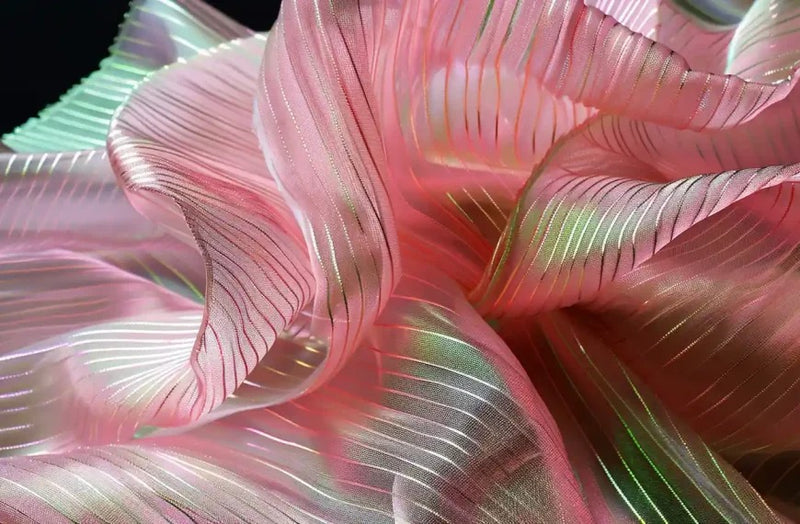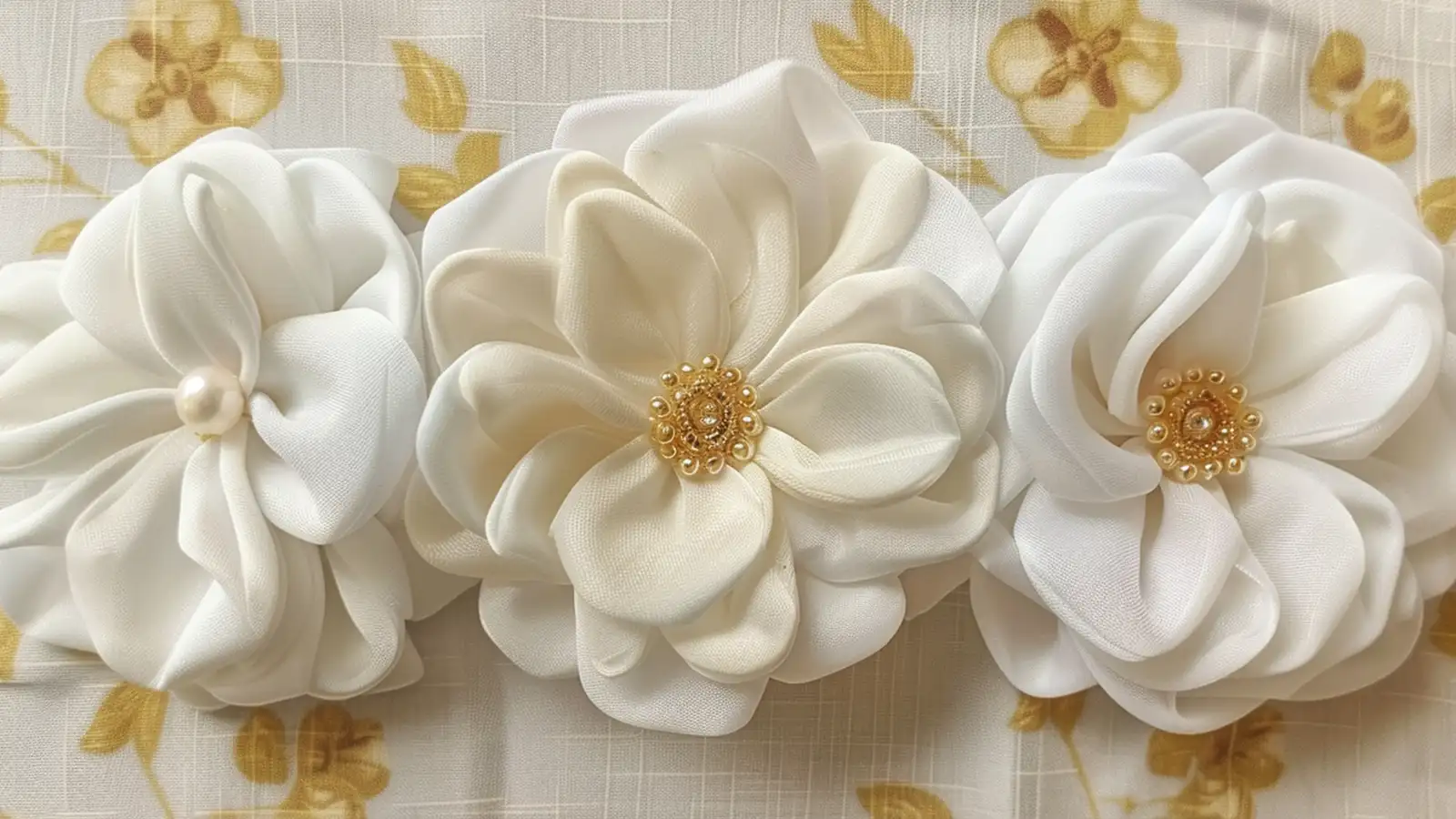
When working with organza fabric, you'll notice that it's different from sewing with other materials. It can be tricky, and a small mistake can cause problems.
But don't worry; you can become skilled at sewing organza with the right techniques. To achieve professional results, you'll need to learn how to prepare the fabric correctly, select the right tools, and use specialized sewing techniques.
And that's just the start. There's more to discover to ensure your project comes out beautifully.
Key Takeaways
- Pre-wash organza fabric gently to soften it and prevent shrinkage during sewing.
- Choose the right needle and thread for organza fabric. Adjust the sewing machine settings to straight stitch.
- Handle delicate organza fabric with care to prevent tears, and use French seams or zigzag stitches to avoid fraying.
- For hemming, use a rolled hem or narrow hem foot. Press the fabric with a dry iron on low to avoid scorching.
- Test stitch settings on scrap fabric before sewing on organza.
How to Sew Organza Fabric: Preparation

As you prepare to sew with organza fabric, you'll want to take a few crucial steps to ensure a successful project.
1. Pre-wash Organza
If you decide to pre-wash your organza, be cautious and gentle. Hand wash it in cold water with mild detergent, and air dry to prevent shrinkage. Avoid wringing or twisting the fabric during washing to maintain its structure and shape.
By pre-washing, you'll soften the organza, making it more pliable for sewing and draping.
2. Cut the Fabric
Now that you've pre-washed and prepared your organza fabric, it's time to cut out your pattern pieces with precision. To do this, you'll need sharp scissors or a rotary cutter to prevent fraying.
Place tissue paper or wax paper under the fabric to provide stability and prevent slipping during cutting. Pin the paper and fabric together using thin appliqué pins to secure the layers. This will ensure accurate cutting and prevent the lightweight organza fabric from shifting.
3. Stabilize the Edges
To ensure your organza fabric holds up to sewing and handling, stabilize its edges by applying lightweight fusible interfacing. This step can prevent fraying and distortion during the sewing process.
Cut the interfacing slightly smaller than the organza piece to avoid bulk in seams. Apply the interfacing to the wrong side of the fabric using a pressing cloth and low heat. Trim excess interfacing close to the fabric edges for a clean finish.
How to Sew Organza Fabric: Sewing Techniques

Now, it's time to focus on the essential sewing techniques for working with organza fabric.
4. Choose the Right Needle and Thread
When working with organza fabric, it is crucial to select the right needle and thread. This can make all the difference in achieving professional-looking results and avoiding frustrating snags and damage.
Use a sharp, thin needle, such as a size 9 or 11, to prevent snags and damage. For thread, opt for a lightweight option like DecoBob 80wt cottonized polyester, which will provide strong, hidden stitches. Make sure to match your needle size to the thread weight for optimal results.
5. Adjust the Sewing Machine Settings
Adjust your sewing machine to a straight stitch setting, specifically designed for sewing delicate fabrics like organza. This setting will help you achieve a smooth, even stitch that won't damage the fabric.
Adjust the stitch length to a longer setting, around 2.5 to 3.0 mm, to prevent puckering. Lower the tension setting slightly to avoid pulling and puckering the fabric.
Remember to avoid backstitching on organza, which can cause fabric damage or puckering.
6. Seaming Techniques
To achieve a professional finish, employ French seams or zigzag stitches to encase raw edges and prevent fraying on your delicate organza fabric.
When seaming, handle the fabric gently to avoid tearing or puckering. Before starting, test your stitch settings on scrap fabric to ensure the best results.
With practice and patience, you'll master the art of seaming organza fabric and create beautiful, long-lasting garments.
7. Hemming Techniques
When hemming organza fabric, opt for techniques that create a delicate, elegant finish, as this fabric demands a subtle, refined edge.
For a classic, sophisticated look, try a rolled hem technique. Alternatively, consider using a narrow hem foot attachment on your sewing machine for precise hemming.
For a more manual approach, hand-sew a baby hem for a fine, nearly invisible edge. If you want something more decorative, experiment with a lettuce hem for a wavy, eye-catching edge.
Whatever technique you choose, practice hemming on scraps of organza fabric to perfect your technique before working on your project.
How to Sew Organza Fabric: Finishing Touches
 As you near the completion of your organza project, it's time to focus on the finishing touches that will elevate your garment from good to great.
As you near the completion of your organza project, it's time to focus on the finishing touches that will elevate your garment from good to great.
8. Press Organza
Your ironing skills are put to the test when working with delicate organza fabric, requiring gentle care to maintain its crisp appearance.
To press organza, use a dry iron on the lowest setting to prevent water spots or discoloration. Always use a pressing cloth to protect the delicate fabric from heat damage. Be cautious with the iron temperature, as excessive heat can easily damage organza.
When pressing seams, take extra care to maintain the fabric's crisp appearance. Proper pressing techniques can enhance your organza project's overall look and finish.
9. Trimming and Embellishments
With your organza fabric pressed to perfection, you can now focus on adding the perfect finishing touches to elevate your project's beauty and sophistication.
Delicate lace trims or satin ribbons can add a touch of elegance to your garment. For a more dramatic effect, consider incorporating intricate beadwork or sequins to give your project a glamorous flair.
You can also experiment with appliqué techniques using contrasting organza fabric to create a unique, textured look. Additionally, you can use decorative stitching like scallops or picot edges to enhance the beauty of your organza pieces.
Troubleshooting Common Issues
When working with organza fabric, you'll likely encounter some common issues that can be frustrating. But don't worry—the proper techniques can quickly address these problems.
Fraying Edges
Fraying edges can be a frustrating issue when sewing with organza. But there are several techniques to address this common problem.
To prevent fraying edges, you can use a serger to secure raw edges or opt for a zigzag stitch on your sewing machine. Trimming seam allowances close to the stitching line also helps reduce fraying. For added reinforcement, consider applying a fray check or fabric glue on the edges.
Another approach is to encase raw edges with French seams, which not only prevents fraying but also creates a clean finish. Practice on scrap fabric to test these techniques and find what works best for you.
Slipping Fabric
To prevent organza fabric from slipping during sewing, use tissue paper or a non-stick sewing machine foot to maintain control. This will help reduce the fabric's slippery nature.
When layering your fabric, secure it with fine pins or clips to maintain alignment and prevent shifting. Consider using a walking foot or a roller foot attachment to feed the slippery organza fabric evenly.
For added grip, lightly spray starch on the organza before sewing. Work on a flat surface and avoid excessive handling to minimize fabric movement during sewing.
Puckering Seams
You'll need to tackle puckering seams head-on to achieve a flawless finish with organza fabric. When sewing with delicate organza, using the right needle size is crucial to prevent puckering. Select a fine needle size (8-11) to ensure a smooth finish.
Additionally, ensure the tension on your sewing machine is adjusted correctly to avoid puckering. Test stitch settings on scrap fabric to find the optimal tension for sewing organza.
Using a walking foot attachment can also help prevent puckering by feeding the fabric evenly. You'll achieve a flawless finish with your organza fabric by making these adjustments.
Conclusion
You've successfully navigated the world of sewing organza fabric! By following these steps, you've ensured a beautiful, professional finish. Remember to handle the fabric with care, choose the right tools, and take your time.
With these techniques, you're ready to create stunning garments and accessories that showcase the beauty of organza. Now, get creative and enjoy the fruits of your labor!
Learn more sewing tips on Longancraft Blog and explore the world of fabrics on Longancraft!
FAQs
Is Organza Fabric Easy to Sew?
You may find organza fabric challenging to work with. Its delicate nature and slippery texture can cause puckering, tearing, or shifting during the sewing process.
Does Organza Fray When Cut?
Due to its delicate nature and loose weave, organza frays easily when cut, causing edges to unravel. To minimize this, use pinking shears or apply a fray-stop solution.
What Is the Best Thread for Sewing Sheer Fabric?
When sewing sheer fabrics, you'll want a strong yet discreet thread. Opt for lightweight threads like DecoBob 80wt or InvisaFil 100wt, which hide stitches well and come in various colors to match your fabric.

0 comments